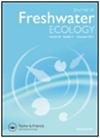Study on microflora structure of Macrobrachium rosenbergii larvae and environmental water at different developmental stages
IF 1.3
4区 环境科学与生态学
Q3 ECOLOGY
引用次数: 0
Abstract
Abstract 16S rRNA gene sequencing was used to analyze the changes in the microbial community structure of Macrobrachium rosenbergii (M. rosenbergii) larvae and environmental water at different stages (0, 7, 14 and 21 days). The PICRUSt was used to precalculated the predicted genes and their functions. The Alpha and Beta diversity analysis showed that the abundance and uniformity of the flora of larvae and water samples were significantly different at four stages. At the phylum level, Proteobacteria, Planctomycetes, Firmicutes and Bacteroidetes were the dominant flora of larvae, while Proteobacteria, Bacteroidetes and Actinobacteria were the dominant flora of environmental water. But at the genus level, Raoultella and Blastopirellula were the main changes in larvae, and Dyadobacter, Flavobacterium and Pseudomonas were the main changes in environmental water. The gene function prediction analysis indicated that the amino acid metabolism, immune system, immune system disease, nervous system, sensory system and other pathways enriched in the different stages of larvae and environmental water were closely related to the breeding of M. rosenbergii. This research might provide theoretical basis and guidance for the high-quality breeding of M. rosenbergii. HIGHLIGHTS The abundance and uniformity of the flora of larvae and environmental water were significantly different at different stages. Several flora were found that related to the growth and development of larval. KEGG pathways enriched at different stages of larvae and environmental water were closely related to the breeding of larvae.罗氏沼虾幼虫不同发育阶段微生物区系结构及环境水分的研究
摘要采用16S rRNA基因测序技术,分析了罗氏沼虾(Macrobrachium rosenbergii, M. rosenbergii)不同生长阶段(0、7、14和21 d)幼虫和环境水体的微生物群落结构变化。PICRUSt用于预计算预测基因及其功能。α和β多样性分析表明,4个阶段幼虫和水样菌群的丰度和均匀性存在显著差异。在门水平上,幼虫的优势菌群为变形菌门、植物菌门、厚壁菌门和拟杆菌门,环境水体的优势菌群为变形菌门、拟杆菌门和放线菌门。但在属水平上,幼虫的变化以Raoultella和Blastopirellula为主,环境水体的变化以Dyadobacter、Flavobacterium和Pseudomonas为主。基因功能预测分析表明,不同阶段幼虫和环境水体中丰富的氨基酸代谢、免疫系统、免疫系统疾病、神经系统、感觉系统等途径与罗氏微孢子虫的繁殖密切相关。本研究可为罗氏沼虾的优质育种提供理论依据和指导。不同时期幼虫区系和环境水体的丰度和均匀性存在显著差异。发现了几种与幼虫生长发育有关的菌群。不同阶段的幼虫和环境水富集的KEGG通路与幼虫的繁殖密切相关。
本文章由计算机程序翻译,如有差异,请以英文原文为准。
求助全文
约1分钟内获得全文
求助全文
来源期刊
CiteScore
2.20
自引率
7.70%
发文量
34
审稿时长
3 months
期刊介绍:
The Journal of Freshwater Ecology, published since 1981, is an open access peer-reviewed journal for the field of aquatic ecology of freshwater systems that is aimed at an international audience of researchers and professionals. Its coverage reflects the wide diversity of ecological subdisciplines and topics, including but not limited to physiological, population, community, and ecosystem ecology as well as biogeochemistry and ecohydrology of all types of freshwater systems including lentic, lotic, hyporheic and wetland systems. Studies that improve our understanding of anthropogenic impacts and changes to freshwater systems are also appropriate.

 求助内容:
求助内容: 应助结果提醒方式:
应助结果提醒方式:


